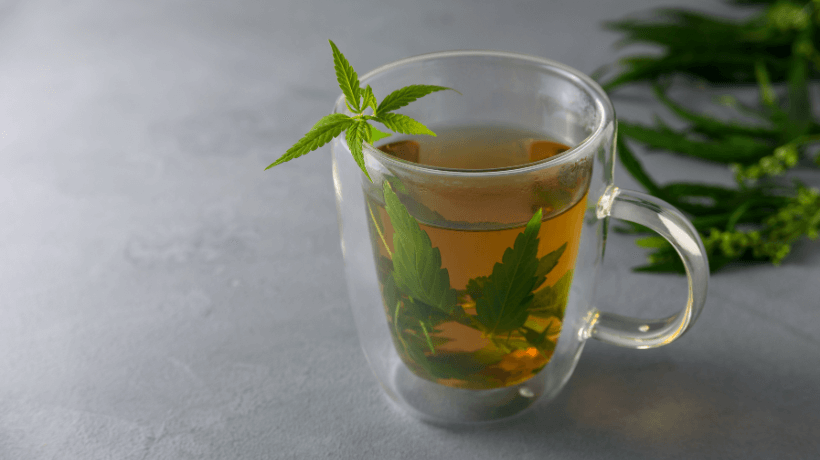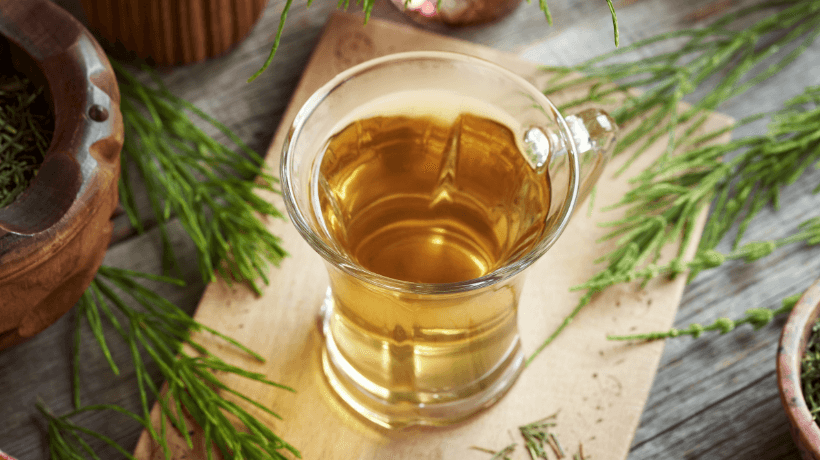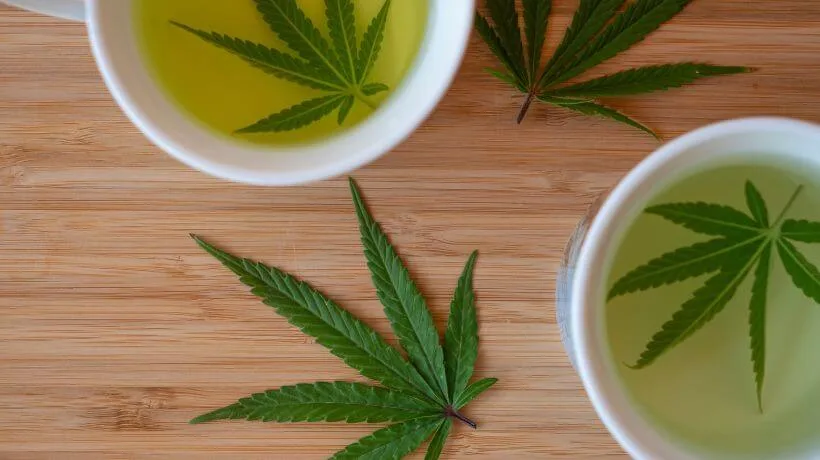Key Takeaways:
- Activating THC through decarboxylation is a crucial first step for creating potent and effective weed stem tea.
- Starting with a low dose and adjusting based on experience ensures a comfortable and enjoyable experience, highlighting the importance of understanding potency.
- Enhancing weed tea with herbs, spices, sweeteners, or dairy can transform it from merely medicinal to a delightful culinary experience.
- Proper grinding, temperature control, and thorough mixing are key to avoiding common pitfalls, ensuring a consistent and enjoyable weed tea experience.
Starting the journey of crafting and enjoying cannabis tea marries the rich tradition of herbal infusions with the therapeutic benefits of cannabis, and drinking weed tea is a great way to relax and let all your stress float away.
This method offers a gentler, controlled experience, ideal for those seeking the plant’s medicinal advantages without the harshness of smoking. It’s important to tread this path with an awareness of legality and safety, as regulations and effects vary widely.
By adhering to local laws and understanding proper dosages, enthusiasts can explore the soothing, nuanced benefits of cannabis tea responsibly, enjoying its potential for relaxation, pain relief, and improved well-being in a comforting, familiar form.

Understanding Cannabis Infusion
The enchanting world of cannabis-infused products offers a unique avenue to experience the benefits of this ancient plant.
To fully appreciate and harness these benefits, especially in the form of weed tea, it’s essential to grasp the basics of cannabis infusion, including the roles of THC and CBD, the decarboxylation process, and the importance of choosing the right strain.
The Basics of Cannabis Infusion
At the heart of cannabis’ effects lie two prominent cannabinoids: THC (Tetrahydrocannabinol) and CBD (Cannabidiol). THC is renowned for its psychoactive properties, delivering the “high” often associated with cannabis use [2].
CBD, on the other hand, does not produce psychoactive effects but is prized for its potential therapeutic benefits, including alleviating anxiety and pain.
How Cannabinoids are Released through Decarboxylation
To activate these cannabinoids, particularly THC, in cannabis tea, decarboxylation is necessary. This process involves gently heating cannabis to convert THCA, a non-psychoactive acid form of THC found in raw plant material, into psychoactive THC.
Decarboxylation is a critical step before infusing cannabis into tea to ensure the final brew is potent and effective [1].
Key Steps for Decarboxylation:
- Grind the cannabis into a coarse powder, akin to the consistency of loose-leaf tea, to maximize the surface area for even heating.
- Spread the ground cannabis on a baking sheet and heat it in the oven at 225-250°F (115-120°C) for 30-40 minutes. This temperature range is optimal for decarboxylation without burning the plant material.
- Stir or shake the cannabis every 10 minutes to ensure even decarboxylation.
- Cool the cannabis for about an hour post-decarboxylation before its infusion into tea.
Neglecting the decarboxylation step would result in a non-psychoactive brew, as boiling water alone does not reach the necessary temperature to activate THC.
Choosing Your Strain
Indica vs. Sativa vs. Hybrid
- Indica strains are typically associated with relaxation and sedative effects, making them suitable for evening use.
- Sativa strains are known for their energizing effects and are often favored for daytime activities.
- Hybrid strains combine traits from Indica and Sativa parents, offering a balanced effect.
CBD-Dominant Strains
For those seeking the medicinal benefits of the cannabis plant without the psychoactive high, CBD-dominant strains are an excellent choice. These strains provide the therapeutic properties of CBD while minimizing the psychoactive effects of THC.
Understanding these aspects of cannabis infusion is crucial for crafting a satisfying and effective weed tea.
By choosing the right strain and properly decarboxylating the cannabis, enthusiasts can tailor their tea experience to their desired effects, whether for relaxation, medicinal purposes, or a gentle energizing boost.
Preparing to Make Weed Tea

Embracing the art of making weed tea begins with a harmonious blend of select ingredients and the right equipment. This preparation phase sets the foundation for an infusion that not only intrigues the palate but also delivers the desired therapeutic and recreational benefits of cannabis.
Ingredients and Equipment Needed
The beauty of marijuana tea lies in its simplicity and the personalized touch one can add. At its core, the recipe calls for:
- Cannabis: Decarboxylated to unlock its full potential.
- Butter or Oil: A fat source is vital for the THC to infuse effectively, as cannabinoids are fat-soluble. Coconut oil or unsalted butter are excellent choices because they blend seamlessly with the tea’s flavors. You can even use cannabis butter or oil.
- Tea: This is the base of your concoction, which can range from classic black tea to herbal or green teas, depending on your preference.
- Optional Enhancements: Honey, mint, lemon, or other herbs and spices can be added to enhance flavor and aroma.
To transform these ingredients into a comforting cup of weed tea, you’ll need the following kitchen tools:
- Grinder: To coarsely grind the cannabis.
- Baking Sheet: For decarboxylating the cannabis in the oven.
- Teapot or Saucepan: To simmer the mixture and allow the infusion to occur.
- Strainer or Cheesecloth: To filter out the plant material, leaving a smooth tea. You can use a coffee filter for this as well.
- Stirring Spoon: To ensure the mixture blends well during the simmering process.
Selecting Your Tea Base
Choosing the right tea base is akin to selecting the canvas for a painting. It sets the tone and complements the complex flavors of cannabis:
- Black Tea: With its bold and robust flavor, black tea pairs well with the earthy tones of cannabis, making it a popular choice for those seeking a potent tea experience.
- Green Tea: For a more subtle infusion, green tea offers a lighter, refreshing taste that harmonizes with milder cannabis strains.
- Herbal Teas: Herbal blends, such as chamomile or peppermint, are ideal for nighttime use. They enhance the relaxing effects of Indica strains. Their diverse flavors also allow for creative pairings with different cannabis profiles.
The Process of Making Cannabis-Infused Tea

Crafting the perfect cup of weed tea involves art, science, and patience. This delicate process ensures the active compounds in cannabis are effectively infused into your brew, creating a soothing and potent tea.
Here’s a step-by-step guide to making weed tea that captures the essence and strength of cannabis.
Decarboxylation: Activating THC
The journey to a potent cup of weed tea begins with decarboxylation, a crucial step to activate THC, the psychoactive compound in the cannabis flower.
Step-by-step guide to decarboxylating cannabis:
- Preheat your oven to 240°F (115°C), creating an even and effective decarboxylation process.
- Grind the cannabis coarsely, akin to loose-leaf tea, to maximize surface area for an even decarboxylation.
- Spread the ground cannabis on a baking sheet, allowing for uniform heat exposure.
- Bake for 30-40 minutes, stirring every 10 minutes to ensure all parts of the cannabis are equally heated.
- Cool the cannabis post-baking, preparing it for the infusion process.
Brewing Your Tea
With decarboxylated cannabis ready, the next step is brewing your tea, a process that beautifully marries the activated cannabis with your chosen tea base.
Infusing fats:
Cannabinoids like THC are fat-soluble, necessitating the presence of a fat source, such as butter or coconut oil, in the brew. This addition ensures the THC is effectively extracted and infused into your tea.
- Simmer the fat and decarboxylated cannabis in water for 15-30 minutes, allowing the THC to infuse into the fat molecules.
Combining decarboxylated cannabis with tea:
- Strain the mixture using cheesecloth or a fine mesh strainer to remove plant material, ensuring a smooth tea.
- Steep your favorite tea bag in the infused water for 3-5 minutes, blending the distinct flavors of the tea with the cannabis.
Straining and Serving
Straining is key to achieving the desired clarity and potency in your weed tea, with cheesecloth or a fine strainer removing any remaining solids.
Tips for straining:
- Ensure a thorough strain to prevent plant matter from affecting the texture and flavor of the tea.
- Gently press the solids to extract every bit of the infused liquid.
Serving suggestions:
Enhance your tea with sweeteners, milk, or lemon according to taste. For those seeking a more potent brew, consider adding kief, cannabis tincture, or a tiny amount of Rick Simpson Oil (RSO) directly to the cup. Remember, these additions are potent; start with small quantities and adjust based on your preference and tolerance.
Consuming cannabis orally, including in tea form, introduces a delayed onset of effects, typically taking 45-60 minutes. This delayed reaction underscores the importance of starting with a low dose and consuming slowly to gauge your response and enjoy a pleasant experience.
Different Recipes for Weed Tea

Exploring the art of making weed tea reveals a spectrum of possibilities, from simple, comforting brews to complex, flavor-rich concoctions.
Each recipe offers a unique experience tailored to your preference for strength, flavor, and effect. Whether you’re a novice or a seasoned enthusiast, there’s a weed tea recipe to match your culinary adventure.
Simple Cannabis Tea
A basic recipe perfect for beginners, simple cannabis tea introduces the gentle effects of cannabis in a familiar, easy-to-make form.
Ingredients:
- 1 gram of decarboxylated cannabis
- 1 teaspoon of butter or coconut oil
- 1 tea bag of your choice (or tea infuser)
- Honey or sugar to taste (optional)
Instructions:
- Combine the decarboxylated cannabis and butter or coconut oil in a saucepan with 2 cups of water.
- Simmer the mixture gently for 15 to 30 minutes to infuse the fat with THC.
- Strain the mixture through a cheesecloth or fine mesh strainer into a mug.
- Steep your tea bag into infused water for 3 to 5 minutes.
- Sweeten with honey or sugar if desired, and enjoy a mild introduction to cannabis tea.
Cannabis Tea with Fat Infusion
For those seeking a more pronounced effect, this enhanced recipe leverages the full potency of cannabis by optimizing the THC infusion into fat.
Ingredients:
- 1 to 2 grams of decarboxylated cannabis
- 2 teaspoons of unsalted butter or coconut oil
- 1 tea bag of your preference
- Optional: milk, honey, or a cinnamon stick for flavor
Instructions:
- Simmer the decarboxylated cannabis with the butter or coconut oil in 2 cups of water for 20 to 40 minutes, allowing for a more potent infusion.
- Strain the liquid into your teapot or mug, pressing the solids to extract the infused fat.
- Add the tea bag and let it steep for 3 to 5 minutes.
- If desired, enhance the tea with milk, honey, or a cinnamon stick for added richness and warmth.
Herbal and Cannabis Tea Blends
For an aromatic and therapeutic experience, blending cannabis with herbal teas offers both flavor and potential health benefits, creating a symphony of taste and effect.
Ingredients:
- 1 gram of decarboxylated cannabis
- 1 teaspoon of coconut oil or butter
- A blend of dried herbs (such as chamomile, peppermint, or lavender)
- Honey or lemon for taste
Instructions:
- Simmer the decarboxylated cannabis and coconut oil or butter in 2 cups of water for 15 to 30 minutes to infuse.
- Add your blend of dried herbs directly to the pot and simmer for an additional 5 minutes.
- Strain the mixture into a teapot or directly into mugs, ensuring clarity.
- Adjust the flavor with honey or a squeeze of lemon, tailoring the brew to your taste preferences.
Tips for a Better Weed Tea Experience
Crafting the perfect cup of weed tea is both an art and a science, blending traditional tea-making practices with the nuanced world of cannabis infusion. Consider these guidelines and tips to elevate your weed tea experience, from dosing to flavor enhancements and storage.
Dosage Guidelines
Understanding the potency of your cannabis and calculating the correct dosage is crucial for a pleasant experience.
- Decarboxylation is key: Always decarboxylate your cannabis to activate THC, ensuring psychoactive effects.
- Mind the ratio: A recommended starting point is 1 cup of ground cannabis to 1 cup of fat. Adjust based on personal tolerance and the potency of your strain.
- Low and slow: Given the delayed onset and prolonged duration of effects (typically 30-90 minutes to kick in, lasting 4-8 hours), start with a small portion and wait at least an hour to gauge the effects before consuming more.
Flavor Enhancements
Enhancing the flavor of your weed tea can transform it from a mere cannabis delivery system into a delightful sensory experience.
- Herbs and spices: Incorporate complementary herbs such as mint, chamomile, or citrus peels to add complexity and counter any grassy cannabis notes.
- Sweeteners and dairy: Honey, sugar, or a dash of milk can soften the bitterness and add a smooth texture to the tea.
Avoiding Common Mistakes
Steer clear of pitfalls that could compromise the taste and efficacy of your weed tea.
- Avoid over-grinding: Cannabis ground to a coarse, salt-like consistency prevents overly grassy flavors.
- Watch the heat: Cooking cannabis at too high a temperature (above 200°C) can degrade THC, reducing potency.
- Stir well: Ensure the cannabis and fat are thoroughly mixed for even potency across servings.
- Test dosages: Especially for newcomers, consuming the entire batch without knowing its strength can lead to overwhelming effects. Start with a small serving and adjust from there.
Storing Leftovers
Proper storage of leftover weed tea ensures that the quality and potency are maintained for future enjoyment.
- Cool it down: Allow the tea to reach room temperature before storing.
- Airtight containers: Store the tea in airtight containers or bottles to preserve its freshness and prevent oxidation.
- Refrigerate: Keep the tea in the refrigerator, which lasts up to 5 days. Gently reheat or enjoy cold.
Crafting weed tea that’s both delicious and effective requires attention to detail, from the initial decarboxylation of your cannabis to the final sip. By following these tips, including proper dosing, flavor enhancements, and avoiding common mistakes, you’ll enhance your tea experience.
Conclusion
Learning the craft of making weed tea blends the tradition of tea brewing with the modern insights of cannabis infusion. This guide navigates through selecting ingredients, mastering dosing, and achieving the perfect infusion, enhancing potency and enjoyment.
Embrace patience and experimentation, and let each cup be a testament to the therapeutic benefits of cannabis. Remember, the journey of crafting weed tea is personal and enriched by exploration.
Start with lower doses, enjoy the flavors, and refine your technique. This path is about the destination and the rich experiences and discoveries made along the way.
[1] Wang, M., Wang, Y.-H., Bharathi Avula, Radwan, M.M., Wanas, A.S., John van Antwerp, Parcher, J.F., ElSohly, M.A. and Khan, I.A. (2016). https://doi.org/10.1089/can.2016.0020.
[2] Perry, D., Ton, J. and Allan, G.M. (2018). Evidence for THC versus CBD in cannabinoids. Canadian family physician Medecin de famille canadien, [online] 64(7), p.519. Available at: https://www.ncbi.nlm.nih.gov/pmc/articles/PMC6042662/.

